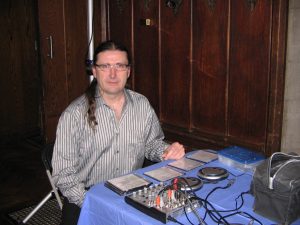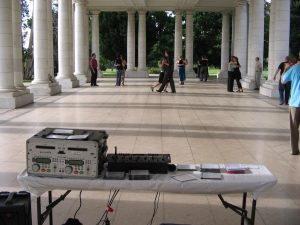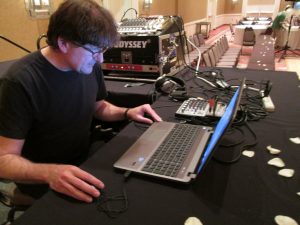This is where I started. I had a relatively small collection of tango CDs and I carried them in a box to the milonga. I would be choosing songs sometimes one at a time using the CD player controls to move around the CD. This required knowing the names of the songs and what they sounded like. Some CDs had good songs in a row so I could dance a bit, but I always had to pay attention and be back at the CD player in time when I needed to manually change songs.
This would have been around 1998 when I started to DJ for milongas. I had a small collection of CDs, maybe 15 or 20, and I listened to them a lot so I knew the music on them. In the early days we didn’t use cortinas. That came after people travelled to Buenos Aires and saw how they worked. Nito Garcia, an older Argentine dancer and teacher told me a useful pattern to use, three tangos, a milonga and a vals, then repeat the pattern. It would sound really strange to do that these days but it made using a small collection of CDs a lot easier.
 The big change came for me when I started hosting the Monday milonga in late 1999. That was when I bought a writing CD ROM drive for my computer, an exotic bit of equipment at the time. I was worried enough about the cost of CDs that I bought re-writable ones thinking that it would cost too much to keep making new ones. That was a silly idea from the start because writable CDs were almost immediately cheap.
The big change came for me when I started hosting the Monday milonga in late 1999. That was when I bought a writing CD ROM drive for my computer, an exotic bit of equipment at the time. I was worried enough about the cost of CDs that I bought re-writable ones thinking that it would cost too much to keep making new ones. That was a silly idea from the start because writable CDs were almost immediately cheap.
By this time I was using cortinas so I would make up whole tandas with cortinas on my CDs. This allowed me to dance to the end of the tanda and gave me time to get back to the DJ booth to start the next tanda. This was important because I was the host of the milonga and had to interact with people. I was also teaching tango classes and it was important to be able to dance with my students, and I just wanted to dance because I was nuts about tango. I didn’t want to just huddle in the DJ booth.
This method allowed me to really focus on making nice tandas. I worked to find just the songs that would work well together and the good cortinas that would go with them. It was a good way to work, the only difficulty was that one had to keep making new CDs or else people would get tired of hearing the same things week after week. Sometimes it was hard to keep ahead of this because of the demands of a day job. And it meant always being attentive to music that would work well as cortinas.
 I came to feel that certain songs were very good as the first songs in a tanda, and there were songs that felt best as the last one in a tanda. There were plenty of songs that worked well in the middle of the tanda. All of the more serious DJs were thinking along these lines and we spent a lot of time at festivals talking together about how we worked, and comparing music. We were each other’s most important critics and together we worked out a lot of ideas.
I came to feel that certain songs were very good as the first songs in a tanda, and there were songs that felt best as the last one in a tanda. There were plenty of songs that worked well in the middle of the tanda. All of the more serious DJs were thinking along these lines and we spent a lot of time at festivals talking together about how we worked, and comparing music. We were each other’s most important critics and together we worked out a lot of ideas.
I liked what I could do with my CDs and kept using this way of DJing long after most people moved on to using computers. I was probably the last person who DJed regularly at festivals that used CDs. I always liked how much I was able to dance, and how I could be on the dance floor and suddenly know what next orchestra I wanted to use. There would be time when I got back to the DJ station to make a quick change.
What I liked most with my CDs was that I could get the best sound quality with them. When people began using computers to DJ the standard sound file format was mp3. I have always hated the sound of the artifacts caused by the lossy compression of the mp3 format. Often files had a low bit rate and too much compression and the result sounded muddy. Very few people understood how to process their own files from CDs and I generally didn’t like the sound. At first it was necessary to have some compression because it was hard to buy hard drives with enough capacity for laptop computers. Later I think people were just lazy, and were sharing sound files around. These days the average computer hard drive has enough capacity that you can use uncompressed files so there really isn’t any difference between playing from a computer and playing from CDs.
 So in the end I began using a computer. It made sense; in fact I waited longer than was necessary. I still remember people being surprised when they saw me using a computer like everyone else, I think they were a bit nostalgic for my old fashioned ways.
So in the end I began using a computer. It made sense; in fact I waited longer than was necessary. I still remember people being surprised when they saw me using a computer like everyone else, I think they were a bit nostalgic for my old fashioned ways.
I don’t miss carrying my CDs and other equipment around with me, but I am glad I spent the time DJing this way. I learned a lot about constructing good tandas that I used when I began working with the computer. I also had a very good library to use when I converted to the computer, I used the same library of sound files I had for making my CDs. The files were well organized and well named so that the library program worked well from the beginning. In that way the transition was fairly easy, and now I have the option of changing things I have set up right up to the last minute.
